igcse 物理大纲
物理IG先行课程大纲
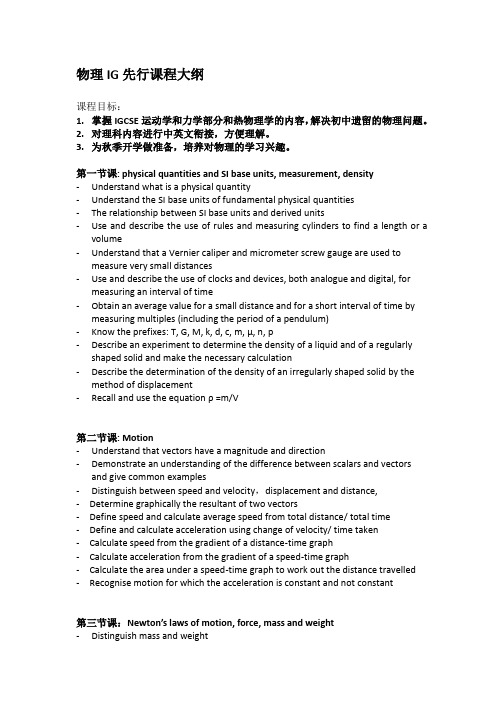
物理IG先行课程大纲
课程目标:
1.掌握IGCSE运动学和力学部分和热物理学的内容,解决初中遗留的物理问题。
2.对理科内容进行中英文衔接,方便理解。
3.为秋季开学做准备,培养对物理的学习兴趣。
第一节课: physical quantities and SI base units, measurement, density
-Understand what is a physical quantity
-Understand the SI base units of fundamental physical quantities
-The relationship between SI base units and derived units
-Use and describe the use of rules and measuring cylinders to find a length or a volume
-Understand that a Vernier caliper and micrometer screw gauge are used to measure very small distances
-Use and describe the use of clocks and devices, both analogue and digital, for measuring an interval of time
-Obtain an average value for a small distance and for a short interval of time by measuring multiples (including the period of a pendulum)
igcse 物理大纲
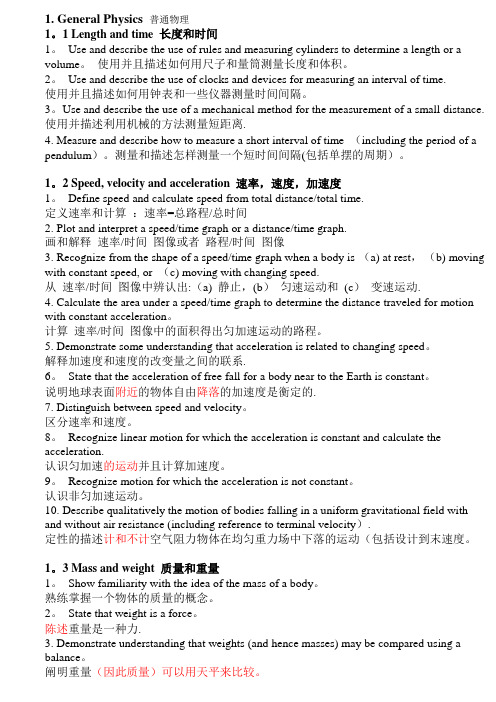
1. General Physics 普通物理
1。1 Length and time 长度和时间
1。Use and describe the use of rules and measuring cylinders to determine a length or a volume。使用并且描述如何用尺子和量筒测量长度和体积。
2。Use and describe the use of clocks and devices for measuring an interval of time.
使用并且描述如何用钟表和一些仪器测量时间间隔。
3。Use and describe the use of a mechanical method for the measurement of a small distance. 使用并描述利用机械的方法测量短距离.
4. Measure and describe how to measure a short interval of time (including the period of a pendulum)。测量和描述怎样测量一个短时间间隔(包括单摆的周期)。
1。2 Speed, velocity and acceleration 速率,速度,加速度
1。Define speed and calculate speed from total distance/total time.
定义速率和计算:速率=总路程/总时间
2. Plot and interpret a speed/time graph or a distance/time graph.
cie ig物理新考纲
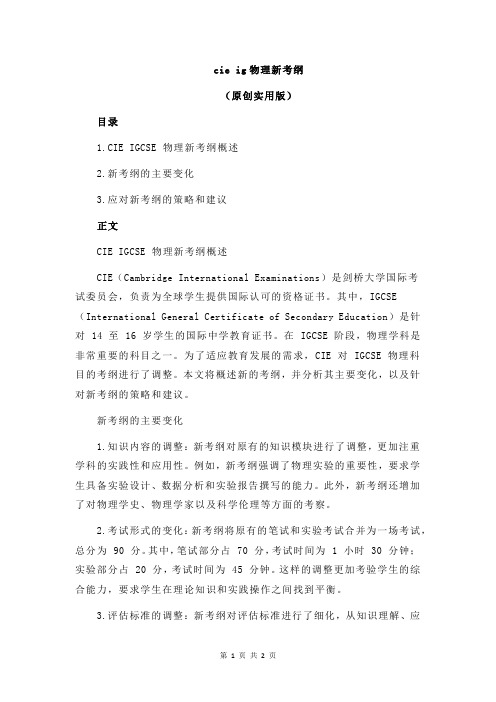
cie ig物理新考纲
(原创实用版)
目录
1.CIE IGCSE 物理新考纲概述
2.新考纲的主要变化
3.应对新考纲的策略和建议
正文
CIE IGCSE 物理新考纲概述
CIE(Cambridge International Examinations)是剑桥大学国际考
试委员会,负责为全球学生提供国际认可的资格证书。其中,IGCSE (International General Certificate of Secondary Education)是针对 14 至 16 岁学生的国际中学教育证书。在 IGCSE 阶段,物理学科是非常重要的科目之一。为了适应教育发展的需求,CIE 对 IGCSE 物理科
目的考纲进行了调整。本文将概述新的考纲,并分析其主要变化,以及针对新考纲的策略和建议。
新考纲的主要变化
1.知识内容的调整:新考纲对原有的知识模块进行了调整,更加注重学科的实践性和应用性。例如,新考纲强调了物理实验的重要性,要求学生具备实验设计、数据分析和实验报告撰写的能力。此外,新考纲还增加了对物理学史、物理学家以及科学伦理等方面的考察。
2.考试形式的变化:新考纲将原有的笔试和实验考试合并为一场考试,总分为 90 分。其中,笔试部分占 70 分,考试时间为 1 小时 30 分钟;实验部分占 20 分,考试时间为 45 分钟。这样的调整更加考验学生的综合能力,要求学生在理论知识和实践操作之间找到平衡。
3.评估标准的调整:新考纲对评估标准进行了细化,从知识理解、应
用能力、分析和评价能力等多方面对学生进行评价。这要求学生在备考过程中,不仅要掌握知识点,还要学会运用知识解决问题,提高自己的思维品质。
igcse物理知识点总结
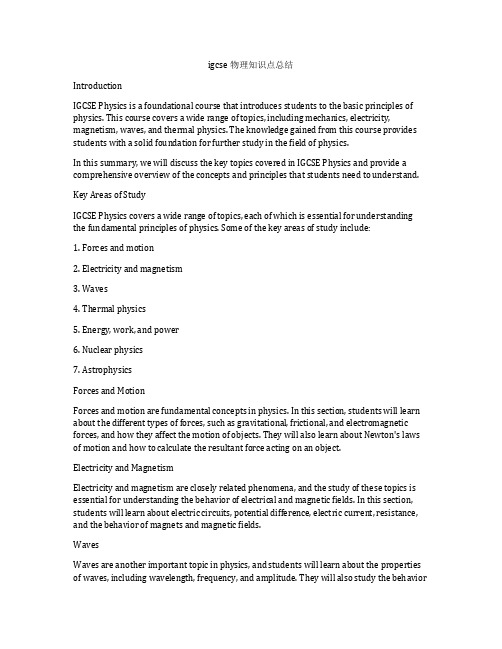
igcse物理知识点总结
Introduction
IGCSE Physics is a foundational course that introduces students to the basic principles of physics. This course covers a wide range of topics, including mechanics, electricity, magnetism, waves, and thermal physics. The knowledge gained from this course provides students with a solid foundation for further study in the field of physics.
In this summary, we will discuss the key topics covered in IGCSE Physics and provide a comprehensive overview of the concepts and principles that students need to understand. Key Areas of Study
IGCSE Physics covers a wide range of topics, each of which is essential for understanding the fundamental principles of physics. Some of the key areas of study include:
cie ig物理新考纲
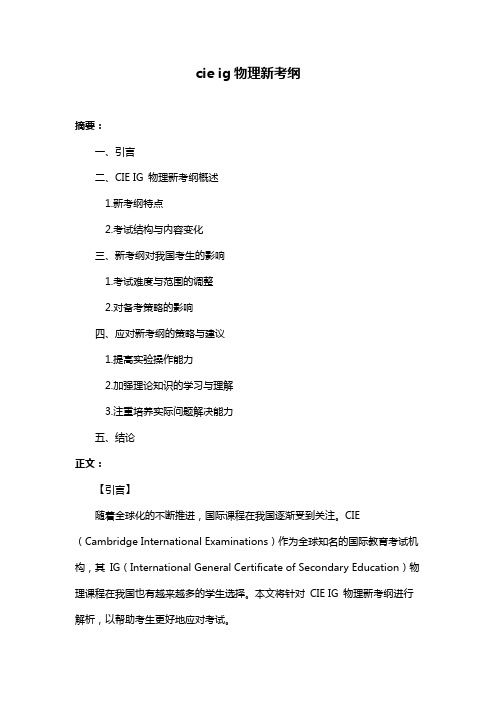
cie ig物理新考纲
摘要:
一、引言
二、CIE IG 物理新考纲概述
1.新考纲特点
2.考试结构与内容变化
三、新考纲对我国考生的影响
1.考试难度与范围的调整
2.对备考策略的影响
四、应对新考纲的策略与建议
1.提高实验操作能力
2.加强理论知识的学习与理解
3.注重培养实际问题解决能力
五、结论
正文:
【引言】
随着全球化的不断推进,国际课程在我国逐渐受到关注。CIE (Cambridge International Examinations)作为全球知名的国际教育考试机构,其IG(International General Certificate of Secondary Education)物理课程在我国也有越来越多的学生选择。本文将针对CIE IG 物理新考纲进行解析,以帮助考生更好地应对考试。
【CIE IG 物理新考纲概述】
【新考纲特点】
CIE IG 物理新考纲注重培养学生的实验操作能力、理论知识的学习与理解以及实际问题解决能力。新考纲更加注重知识的应用,强调理论与实践相结合,使学生能够更好地应对未来的学习和工作。
【考试结构与内容变化】
新考纲将考试分为两个部分:Paper 1 和Paper 2。Paper 1 包括选择题、填空题和简答题,主要考察学生对物理概念、定律和理论的理解与应用;Paper 2 为实验操作题,要求学生在规定时间内完成实验操作,并撰写实验报告。新考纲的内容涵盖了力学、热力学、电磁学、光学和现代物理等领域,要求学生对这些领域有较为全面的了解。
【新考纲对我国考生的影响】
【考试难度与范围的调整】
国际课程IGCSE剑桥物理 chap18
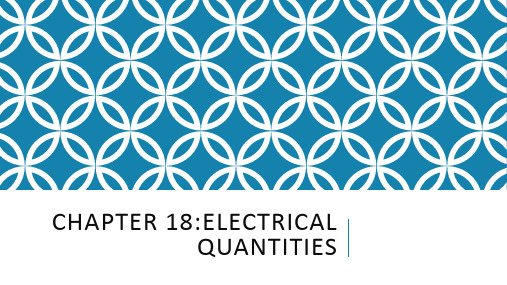
INTRODUCTION
When electric charges start moving we say that there is a flow of electric current. Of course, electric current can not flow through everything. Materials that conduct electric current well are called conductors while materials that conduct badly are called insulators. In this and the following chapters, we will be concentrating on investigating the flow of electric current in an electric circuit. This is a closed loop network that contains a number of electrical components. In this chapter you will learn: •To explain how electric circuits work using notions of current, resistance, and potential difference. •How to measure and calculate electrical resistance. •How to calculate energy and power in electric circuits.
国际课程IGCSE剑桥物理chap13
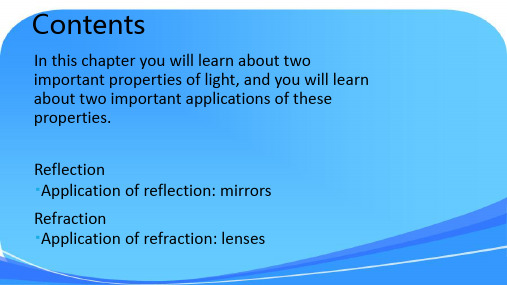
The majority of light refracts with r = 90° and a minority will reflect if i = c.
All of the light will be reflected if i > c. In this case we have total internal reflection
•The angles are measured with respect to the normal line. This is the line perpendicular to the reflecting surface.
Application of Reflection: Mirrors •The mirror is a reflecting surface and using the Law of Reflection we
•Light rays that enter the lens through the focal point of the lens are turned into parallel lines.
Application of Refraction: Lenses When an object is placed in front of the focal point, the
英国初中物理IGCSE考试简介
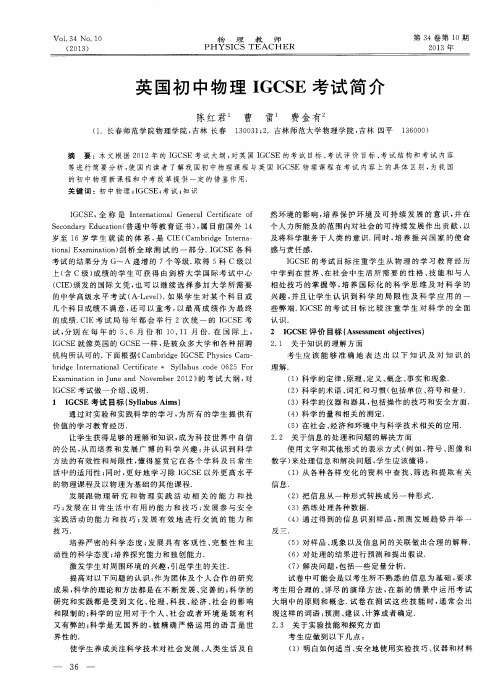
br i dge I nt e r na t i o na l Ce r t i f i c a t e * Syl l a b us c od e 0 6 25 Fo r
试, 分别 在 每 年 的 5 、 6月 份 和 1 O 、 l 1月 份 . 在 国际 上 ,
相处技 巧的掌握 等 , 培 养 国 际 化 的 科 学 思 维 及 对 科 学 的 兴趣 , 并 且 让 学 生 认 识 到 科 学 的 局 限 性 及 科 学 应 用 的 一 些弊端 . I G C S E的 考 试 目标 比 较 注 重 学 生 对 科 学 的 全 面
的初 中物理 新 课 程 和 中考 改革 提 供 一 定 的 借 鉴 作 用 . 关 键 词 :初 中物 理 ; I G C S E; 考试 ; 知识 I G C S E, 全称 是 I n t e r n a t i o n a l G e n e r a l C e r t i f i c a t e o f S e c o n d a r y E d u c a t i o n ( 普 通 中 等 教 育证 书 ) , 属 目前 国外 1 4 岁至 1 6岁 学 生 就 读 的 体 系 , 是 C I E( C a m b r i d g e I n t e r n a —
cambridge igcse physics 教材介绍
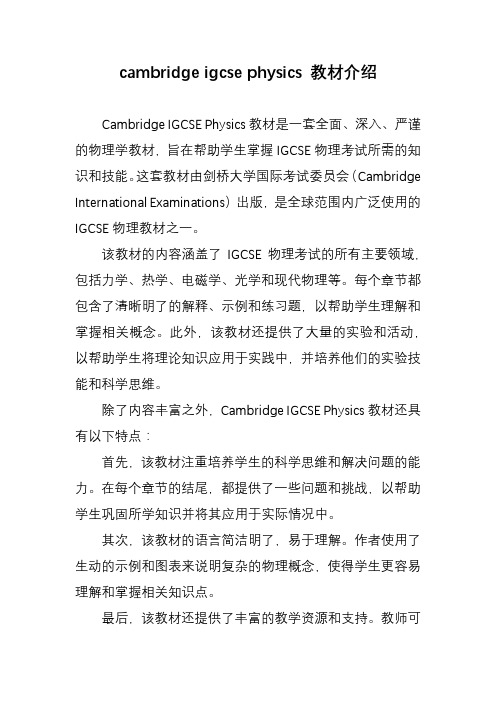
cambridge igcse physics 教材介绍
Cambridge IGCSE Physics教材是一套全面、深入、严谨的物理学教材,旨在帮助学生掌握IGCSE物理考试所需的知识和技能。这套教材由剑桥大学国际考试委员会(Cambridge International Examinations)出版,是全球范围内广泛使用的IGCSE物理教材之一。
该教材的内容涵盖了IGCSE物理考试的所有主要领域,包括力学、热学、电磁学、光学和现代物理等。每个章节都包含了清晰明了的解释、示例和练习题,以帮助学生理解和掌握相关概念。此外,该教材还提供了大量的实验和活动,以帮助学生将理论知识应用于实践中,并培养他们的实验技能和科学思维。
除了内容丰富之外,Cambridge IGCSE Physics教材还具有以下特点:
首先,该教材注重培养学生的科学思维和解决问题的能力。在每个章节的结尾,都提供了一些问题和挑战,以帮助学生巩固所学知识并将其应用于实际情况中。
其次,该教材的语言简洁明了,易于理解。作者使用了生动的示例和图表来说明复杂的物理概念,使得学生更容易理解和掌握相关知识点。
最后,该教材还提供了丰富的教学资源和支持。教师可
以使用该教材配套的教师指南、试题库和在线资源来辅助教学,提高学生的学习效果。
总之,Cambridge IGCSE Physics教材是一套优秀的IGCSE物理教材,它的内容丰富、语言简洁明了、注重培养学生的科学思维和解决问题的能力。使用该教材可以帮助学生全面掌握IGCSE物理考试所需的知识和技能,为未来的学习和职业生涯打下坚实的基础。
全国高中物理竞赛考纲(绝对完整)
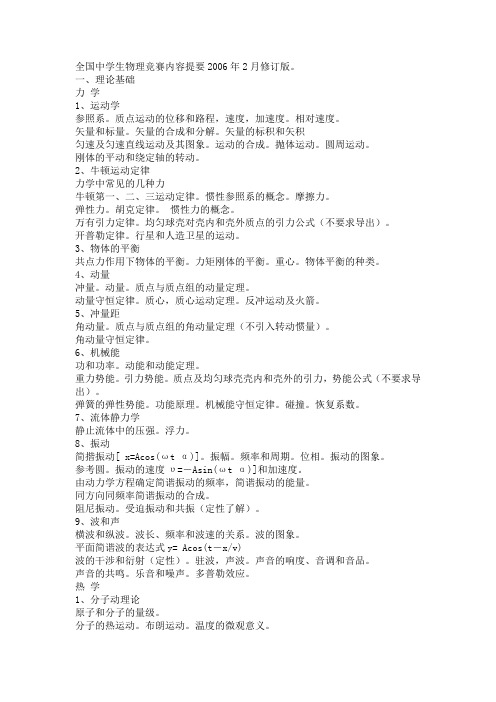
全国中学生物理竞赛内容提要2006年2月修订版。
一、理论基础
力学
1、运动学
参照系。质点运动的位移和路程,速度,加速度。相对速度。
矢量和标量。矢量的合成和分解。矢量的标积和矢积
匀速及匀速直线运动及其图象。运动的合成。抛体运动。圆周运动。
刚体的平动和绕定轴的转动。
2、牛顿运动定律
力学中常见的几种力
牛顿第一、二、三运动定律。惯性参照系的概念。摩擦力。
弹性力。胡克定律。惯性力的概念。
万有引力定律。均匀球壳对壳内和壳外质点的引力公式(不要求导出)。
开普勒定律。行星和人造卫星的运动。
3、物体的平衡
共点力作用下物体的平衡。力矩刚体的平衡。重心。物体平衡的种类。
4、动量
冲量。动量。质点与质点组的动量定理。
动量守恒定律。质心,质心运动定理。反冲运动及火箭。
5、冲量距
角动量。质点与质点组的角动量定理(不引入转动惯量)。
角动量守恒定律。
6、机械能
功和功率。动能和动能定理。
重力势能。引力势能。质点及均匀球壳壳内和壳外的引力,势能公式(不要求导出)。
弹簧的弹性势能。功能原理。机械能守恒定律。碰撞。恢复系数。
7、流体静力学
静止流体中的压强。浮力。
8、振动
简揩振动[ x=Acos(ωt α)]。振幅。频率和周期。位相。振动的图象。
参考圆。振动的速度υ=-Asin(ωt α)]和加速度。
由动力学方程确定简谐振动的频率,简谐振动的能量。
同方向同频率简谐振动的合成。
阻尼振动。受迫振动和共振(定性了解)。
9、波和声
横波和纵波。波长、频率和波速的关系。波的图象。
平面简谐波的表达式y= Acos(t-x/v)
波的干涉和衍射(定性)。驻波,声波。声音的响度、音调和音品。
cambridge igcse physics 教材介绍
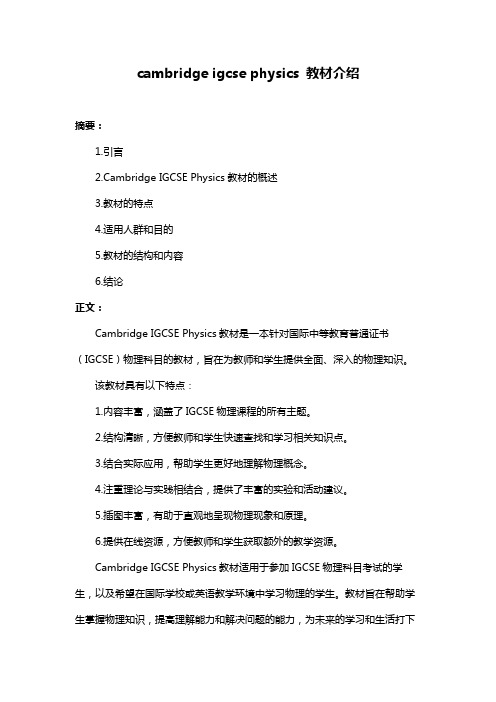
cambridge igcse physics 教材介绍
摘要:
1.引言
2.Cambridge IGCSE Physics教材的概述
3.教材的特点
4.适用人群和目的
5.教材的结构和内容
6.结论
正文:
Cambridge IGCSE Physics教材是一本针对国际中等教育普通证书(IGCSE)物理科目的教材,旨在为教师和学生提供全面、深入的物理知识。
该教材具有以下特点:
1.内容丰富,涵盖了IGCSE物理课程的所有主题。
2.结构清晰,方便教师和学生快速查找和学习相关知识点。
3.结合实际应用,帮助学生更好地理解物理概念。
4.注重理论与实践相结合,提供了丰富的实验和活动建议。
5.插图丰富,有助于直观地呈现物理现象和原理。
6.提供在线资源,方便教师和学生获取额外的教学资源。
Cambridge IGCSE Physics教材适用于参加IGCSE物理科目考试的学生,以及希望在国际学校或英语教学环境中学习物理的学生。教材旨在帮助学生掌握物理知识,提高理解能力和解决问题的能力,为未来的学习和生活打下
坚实的基础。
教材的结构和内容如下:
1.章节概述:简要介绍本章的主题和内容。
2.主题:按照IGCSE物理课程的要求,分为不同的主题,如力学、热力学、电磁学等。
3.子主题:每个主题下包含若干子主题,详细讲解相关知识点。
4.定义和概念:给出重要物理概念的定义,帮助学生理解和记忆。
5.理论和实践:结合理论知识和实验,加深对物理原理的理解。
6.练习题:提供丰富的练习题,帮助学生巩固所学知识。
7.词汇表:列举本章涉及的重要词汇,方便学生查阅和学习。
国际课程IGCSE剑桥物理 chap13

APPLICATION OF REFRACTION: LENSES
When an object is placed in between the focal point and the lens, the lens will produce an image that is: Upright Magnified (bigger than the object) Further from the lens than the object Virtual A magnifying glass works like this!
CHAPTER 13: LIGHT
CONTENTS
In this chapter you will learn about two important properties of light, and you will learn about two important applications of these properties. Reflection Application of reflection: mirrors
•The mirror is a reflecting surface and using the Law of Reflection we can construct a ray diagram to determine how objects are reflected.
IGCSE物理
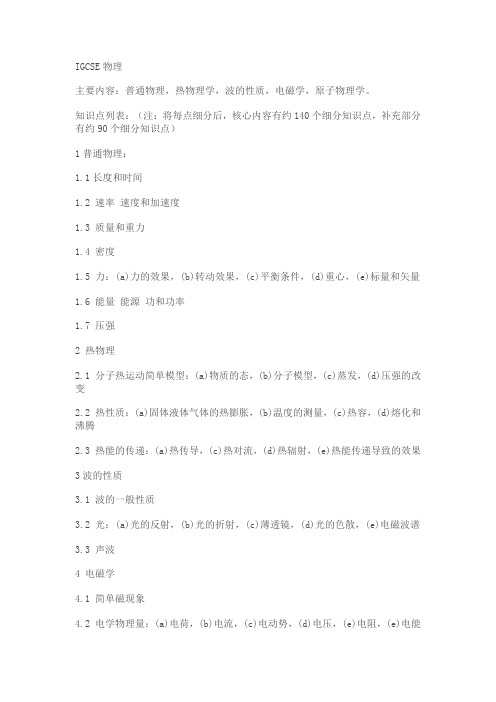
IGCSE物理
主要内容:普通物理,热物理学,波的性质,电磁学,原子物理学。
知识点列表:(注:将每点细分后,核心内容有约140个细分知识点,补充部分有约90个细分知识点)
1普通物理:
1.1长度和时间
1.2 速率速度和加速度
1.3 质量和重力
1.4 密度
1.5 力:(a)力的效果,(b)转动效果,(c)平衡条件,(d)重心,(e)标量和矢量
1.6 能量能源功和功率
1.7 压强
2 热物理
2.1 分子热运动简单模型:(a)物质的态,(b)分子模型,(c)蒸发,(d)压强的改变
2.2 热性质:(a)固体液体气体的热膨胀,(b)温度的测量,(c)热容,(d)熔化和沸腾
2.3 热能的传递:(a)热传导,(c)热对流,(d)热辐射,(e)热能传递导致的效果
3波的性质
3.1 波的一般性质
3.2 光:(a)光的反射,(b)光的折射,(c)薄透镜,(d)光的色散,(e)电磁波谱
3.3 声波
4 电磁学
4.1 简单磁现象
4.2 电学物理量:(a)电荷,(b)电流,(c)电动势,(d)电压,(e)电阻,(e)电能
4.3 电路:(a)电路图,(b)串联,(c)并联,(d)电路元件的作用和使用,(e)数字电路电子学
4.4 安全用电和电的危害
4.5 电磁效应:(a)电磁感应,(b)交流发电机,(c)变压器,(e)电流的磁效应,
(f)通电导体在磁场中受力,(g)直流电动机
4.6 阴极射线示波器:(a)阴极射线,(b)阴极射线示波器的简单实用
5 原子物理
5.1 放射性:(a)放射性探测,(b)三种放射性基本特征,(c)放射性衰变,(d)半衰期,(e)安全事项
国际课程IGCSE剑桥物理 chap14
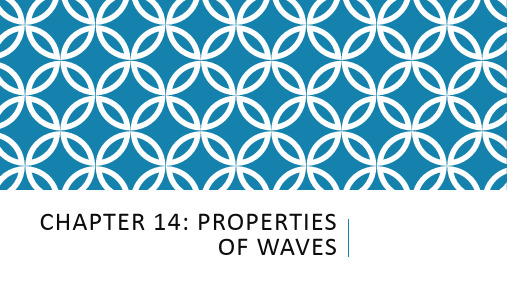
WAVES
In this chapter you will learn the following: 1. What a wave is and what type of waves there are. 2. How to represent a wave by a wave graph and how to characterize it by its frequency, amplitude, period, wavelength and wave speed. 3. How water waves manifest the wave phenomena of reflection, refraction, and diffraction.
There are many type of waves and one way to categorize them is by looking at their direction of oscillation: Longitudinal waves: waves where the oscillation to parallel to the direction of the wave propagation Transverse waves: waves where the oscillation is perpendicular to the direction of the wave propagation
ig化学爱德思大纲
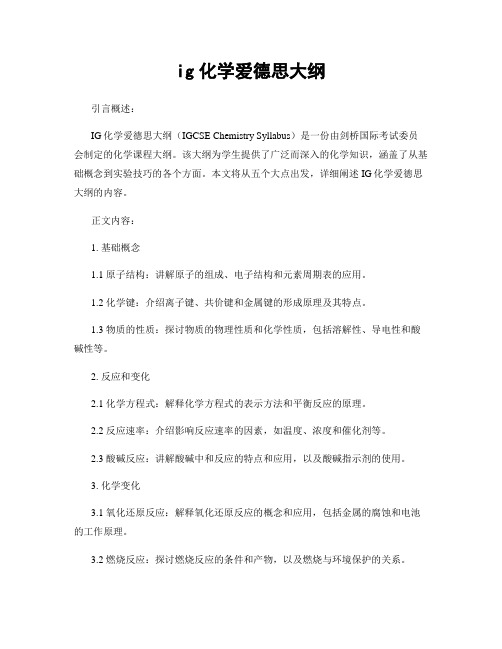
ig化学爱德思大纲
引言概述:
IG化学爱德思大纲(IGCSE Chemistry Syllabus)是一份由剑桥国际考试委员会制定的化学课程大纲。该大纲为学生提供了广泛而深入的化学知识,涵盖了从基础概念到实验技巧的各个方面。本文将从五个大点出发,详细阐述IG化学爱德思大纲的内容。
正文内容:
1. 基础概念
1.1 原子结构:讲解原子的组成、电子结构和元素周期表的应用。
1.2 化学键:介绍离子键、共价键和金属键的形成原理及其特点。
1.3 物质的性质:探讨物质的物理性质和化学性质,包括溶解性、导电性和酸碱性等。
2. 反应和变化
2.1 化学方程式:解释化学方程式的表示方法和平衡反应的原理。
2.2 反应速率:介绍影响反应速率的因素,如温度、浓度和催化剂等。
2.3 酸碱反应:讲解酸碱中和反应的特点和应用,以及酸碱指示剂的使用。
3. 化学变化
3.1 氧化还原反应:解释氧化还原反应的概念和应用,包括金属的腐蚀和电池的工作原理。
3.2 燃烧反应:探讨燃烧反应的条件和产物,以及燃烧与环境保护的关系。
3.3 电解反应:介绍电解反应的原理和应用,包括电镀和电解质溶液的导电性。
4. 化学分析
4.1 颜色和气味:讲解颜色和气味在化学分析中的应用,如指示剂和气体检测剂。
4.2 离子测试:介绍常见离子的测试方法,如铁离子的试剂反应和氯离子的沉淀反应。
4.3 光谱分析:探讨光谱分析的原理和应用,如紫外可见光谱和红外光谱。
5. 实验技巧
5.1 安全操作:强调实验室安全操作的重要性,包括穿戴实验室服装和正确使用实验室设备。
- 1、下载文档前请自行甄别文档内容的完整性,平台不提供额外的编辑、内容补充、找答案等附加服务。
- 2、"仅部分预览"的文档,不可在线预览部分如存在完整性等问题,可反馈申请退款(可完整预览的文档不适用该条件!)。
- 3、如文档侵犯您的权益,请联系客服反馈,我们会尽快为您处理(人工客服工作时间:9:00-18:30)。
1. General Physics 普通物理
1.1 Length and time 长度和时间
1. Use and describe the use of rules and measuring cylinders to determine a length or a volume. 使用并且描述如何用尺子和量筒测量长度和体积。
2. Use and describe the use of clocks and devices for measuring an interval of time.
使用并且描述如何用钟表和一些仪器测量时间间隔。
3. Use and describe the use of a mechanical method for the measurement of a small distance. 使用并描述利用机械的方法测量短距离。
4. Measure and describe how to measure a short interval of time (including the period of a pendulum). 测量和描述怎样测量一个短时间间隔(包括单摆的周期)。
1.2 Speed, velocity and acceleration 速率,速度,加速度
1. Define speed and calculate speed from total distance/total time.
定义速率和计算:速率=总路程/总时间
2. Plot and interpret a speed/time graph or a distance/time graph.
画和解释速率/时间图像或者路程/时间图像
3. Recognize from the shape of a speed/time graph when a body is (a) at rest, (b) moving with constant speed, or (c) moving with changing speed.
从速率/时间图像中辨认出:(a) 静止,(b) 匀速运动和(c) 变速运动。
4. Calculate the area under a speed/time graph to determine the distance traveled for motion with constant acceleration.
计算速率/时间图像中的面积得出匀加速运动的路程。
5. Demonstrate some understanding that acceleration is related to changing speed.
解释加速度和速度的改变量之间的联系。
6. State that the acceleration of free fall for a body near to the Earth is constant.
说明地球表面附近的物体自由降落的加速度是衡定的。
7. Distinguish between speed and velocity.
区分速率和速度。
8. Recognize linear motion for which the acceleration is constant and calculate the acceleration.
认识匀加速的运动并且计算加速度。
9. Recognize motion for which the acceleration is not constant.
认识非匀加速运动。
10. Describe qualitatively the motion of bodies falling in a uniform gravitational field with and without air resistance (including reference to terminal velocity).
定性的描述计和不计空气阻力物体在均匀重力场中下落的运动(包括设计到末速度。
1.3 Mass and weight 质量和重量
1. Show familiarity with the idea of the mass of a body.
熟练掌握一个物体的质量的概念。
2. State that weight is a force.
陈述重量是一种力。
3. Demonstrate understanding that weights (and hence masses) may be compared using a balance.
阐明重量(因此质量)可以用天平来比较。
4. Demonstrate an understanding that mass is a property which 'resists' change in motion.
阐明质量是物体阻碍加速度的一种性质
5. Describe, and use the concept of, weight as the effect of a gravitational field on a mass.
描述和利用重力是重力场作用在物体上的效果的概念。
1.4 Density 密度
1. Describe an experiment to determine the density of a liquid and of a regularly shaped solid and make the necessary calculation.
描述一个测量液体或者规则形状的固体的密度的实验并做必要的计算。
2. Describe the determination of the density of an irregularly shaped solid by the method of displacement and make the necessary calculation.
描述通过替代法测量一个不规则形状的固体的密度并做必要的计算。
1.5 Force 力
(a) Effects of forces 力的作用效果
1. State that a force may produce a change in size and shape of a body.
说明一个力可以改变一个物体的大小和形状。
2. Plot extension/load graphs and describe the associated experimental procedure.
画伸长量/力的图像并描述这个相关实验过程。
3. Describe the ways in which a force may change the motion of a body.
描述力可以怎样改变一个物体的运动。
4. Find the resultant of two or more forces acting along the same line.
求共线的两个或多个力的合力。
10. Interpret extension/load graphs.
解释伸长量/负荷的图象。
11. S tate Hooke’s Law and rec all and use the expression F = k x.
说明胡克定律并记住使用F=kx。
12. Recognize the significance of the term 'limit of proportionality' for an extension/load graph. 从伸长量/负荷图像中辨认出正比例限度。
13. Recall and use the relation between force, mass and acceleration (including the direction). 记住和应用力,质量和加速度之间的关系。(F=ma)。
14. Describe, qualitatively, motion in a curved path due to a perpendicular force (F = mv2 / r is not required).
定性的描述物体在一个垂直力的作用下沿曲线运动。
(b) Turning effect 转动效果
5. Describe the moment of a force as a measure of its turning effect and give everyday examples. 描述力矩是力的转动效果量度并且取例子。
6. Describe, qualitatively, the balancing of a beam about a pivot.
定性的描述一个杆关于支点的平衡。
15. Perform and describe an experiment (involving vertical forces) to verify that there is no net moment on a body in equilibrium.
演示和描述一个实验证明物体在合力矩为零时会保持平衡。
16. Apply the idea of opposing moments to simple systems in equilibrium.
应用反向的力矩简化一个系统的平衡。
(c) Conditions for equilibrium 平衡的条件
7. State that, when there is no resultant force and no resultant turning effect, a system is in equilibrium. 描述当合力为零并且合力矩为零时,系统保持平衡。
(d) Centre of mass 质心
8. Perform and describe an experiment to determine the position of the centre of mass of a
